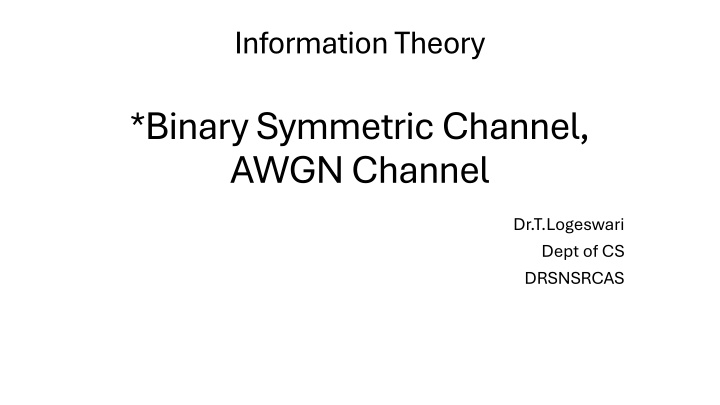
Binary Symmetric Channel and AWGN Channel in Information Theory
Explore the concepts of Binary Symmetric Channel (BSC) and Additive White Gaussian Noise (AWGN) Channel in information theory. Learn how these channels work, their characteristics, and their role in communication systems. Discover practical examples and the implementation of error correction schemes using binary triple repetition codes.
Download Presentation

Please find below an Image/Link to download the presentation.
The content on the website is provided AS IS for your information and personal use only. It may not be sold, licensed, or shared on other websites without obtaining consent from the author. If you encounter any issues during the download, it is possible that the publisher has removed the file from their server.
You are allowed to download the files provided on this website for personal or commercial use, subject to the condition that they are used lawfully. All files are the property of their respective owners.
The content on the website is provided AS IS for your information and personal use only. It may not be sold, licensed, or shared on other websites without obtaining consent from the author.
E N D
Presentation Transcript
Information Theory *Binary Symmetric Channel, AWGN Channel Dr.T.Logeswari Dept of CS DRSNSRCAS
Binary Symmetric Channe A binary symmetric channel (or BSC) is a common communications channel model used in coding theory and information theory. In this model, a transmitter wishes to send a bit (a zero or a one), and the receiver receives a bit. It is assumed that the bit is usually transmitted correctly, but that it will be "flipped" with a small probability (the "crossover probability"). This channel is used frequently in information theory because it is one of the simplest channels to analyze.
A binary symmetric channel with crossover probability p denoted by, is a channel with binary input and binary output and probability of error p; that is, if X is the transmitted random variable and Y the received variable, then the channel is characterized by the conditional probabilities
AWGN Channel The Additive White Gaussian Noise (AWGN) channel is another important channel model in information theory. Unlike the binary symmetric channel, the AWGN channel is a continuous channel that is often used to model the effects of noise in analog communication systems. In the AWGN channel: Channel Characteristics Channel Characteristics: The channel introduces Gaussian noise to the transmitted signal. The noise is assumed to be white, meaning it has a constant power spectral density across all frequencies. The noise is additive, meaning it is added to the transmitted signal.
Channel Model Channel Model: The received signal Y can be expressed as the sum of the transmitted signal X and the noise Y=X+N Signal Signal- -to to- -Noise Ratio (SNR): Noise Ratio (SNR): The quality of the communication channel is often described by the Signal-to-Noise Ratio (SNR), defined as the ratio of the signal power to the noise power. A Simple Channel Code A Simple Channel Code We consider the transmission of the binary information sequence 001 0 1 110 over a binary symmetric channel with bit error probability = 0.25 . On average, every fourth binary symbol will be received incorrectly. In this example we assume that the binary sequence 000 0 0 110 is received at the output of the binary symmetric channel
In order to implement a simple error correction scheme we make use of the so-called binary triple repetition binary triple repetition code. This simple channel code is used for the encoding of binary data. If the binary symbol 0 binary symbol 0 is to be transmitted, the encoder emits the code word 000 code word 000. Alternatively, the code word 111 encoder when the binary symbol 1 binary symbol 1 is to be transmitted. The encoder of a triple repetition code is illustrated in above image. For the binary information sequence given above we obtain the binary code sequence 000 000 111 000 111 111 111 000 at the output of the encoder. If we again assume that on average every fourth binary symbol is incorrectly transmitted by the binary symmetric channel, we may obtain the received sequence 010 000 011 010 111 010 111 010 code word 111 is issued by the
Decoder of a triple repetition code The decoder tries to estimate the original information sequence with the help of a majority decision. If the number of 0s within a received 3-bit word is larger than the number of 1s, the decoder emits the binary symbol 0; otherwise a 1 is decoded. With this decoding algorithm we obtain the decoded information sequence 001010 1 0
